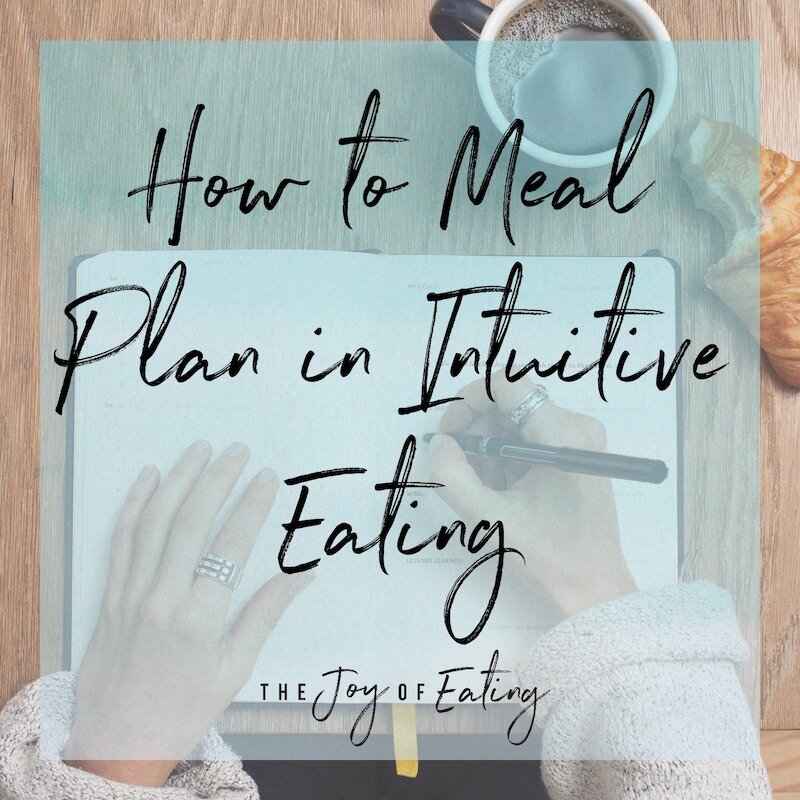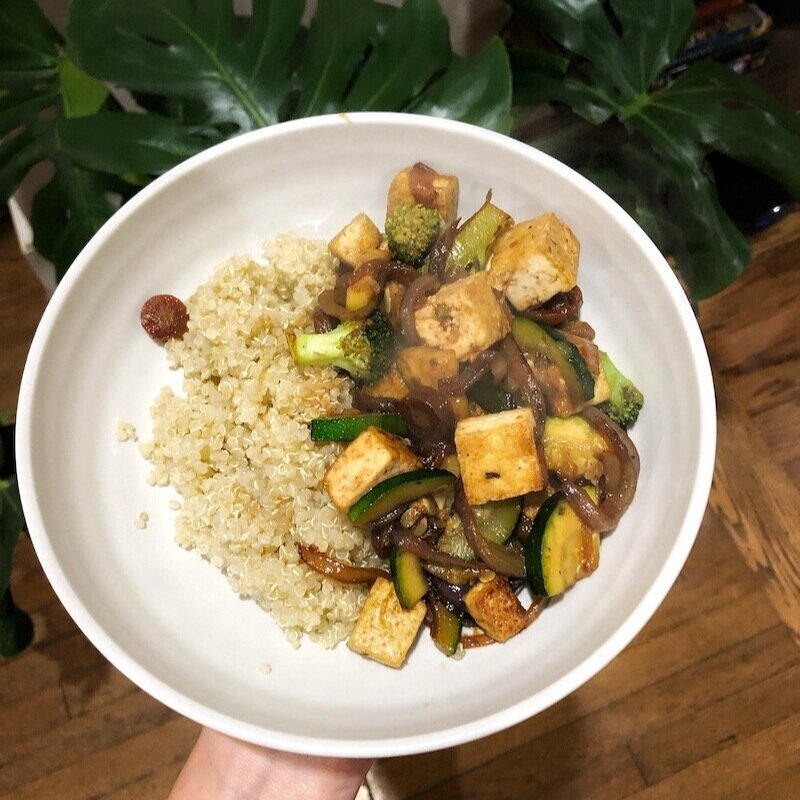Intuitive Kitchen: How to Stock Your Kitchen for Intuitive Eating
Intuitive eating works by building trust that adequate and pleasurable food is always coming. One way to do that is by stocking your kitchen with the ingredients to easily prepare satisfying meals. Read this post to learn how to stock your kitchen for intuitive eating.
This post contains excerpts from my book, Gentle Nutrition. Pre-order today (it's available Feb 23rd 2021!) from Amazon or support independent bookshops and order on Bookshop.org. Pre-orders are greatly appreciated, as it makes a huge difference for the book release!
Intuitive eating works is by creating food security and trust that adequate and pleasurable food is always coming. One of the ways we do that is by ditching the diet mentality. Another is by honoring our hunger, and eating before we hit ravenous levels of hunger. Still another is by making peace with food and giving ourselves unconditional permission to eat the foods we want, when we want them.
Another way you can foster food security is a bit more practical - by stocking your kitchen with foods you can keep in your pantry, freezer and fridge, and use to create satisfying meals. It’s a simple thing, but having a well stocked kitchen is incredibly helpful for reducing stress around food. Think about how it feels when you don’t have time to cook what you planned to eat for dinner, or aren’t in the mood for it? Or the stress of running out of an ingredient and not having anything available for backup. Or the stress of meal planning in general! Isn’t it nice to be able to just pick up a few fresh foods and be able to throw together dinner without having a rigid plan?
Because of that, in my book Gentle Nutrition, I included a section on how to stock your pantry for intuitive eating. One of my goals of the book was the provide the practical food self care skills to help you put intuitive eating, and gentle nutrition into practice. I hope this sneak peek is helpful for you!
How to Stock Your Kitchen for Intuitive Eating
Pantry
Pasta: Pasta is great for throwing together an easy and satisfying meal. Just add a store-bought sauce, sautéed or frozen vegetables, and a pantry protein, like canned tuna, a crumbled veggie burger, or canned beans. This pasta puttanesca and this spinach and white bean pasta are two of my staple pantry pasta recipes.
Grains: I like to have different grains on hand. Some grains, like brown rice or farro take a long time to cook, so I would recommend having some quick-cooking whole grains, like quinoa or white rice, for weeknight meals.
Oats: Oats are more versatile than you imagine! Having a bag of rolled oats around is great for making a quick breakfast of oatmeal or overnight oats, but you can also add them to smoothies for fiber and filling carbs, put them in muffins or cookies, or blend them with nut butter and honey to make energy balls.
Boxed pasta/rice/grain mixes: Whether it’s boxed mac and cheese or a seasoned rice or quinoa mix, these convenient foods make for a simple and tasty side dish or something you can add fat, protein and produce to and create a satisfying, balanced meal. This one dish spinach-parmesan risotto with salmon is a perfect example!
Tortilla chips: Between eating them as snacks and incorporating them into an entrée, I go through a big bag of tortilla chips week! Try this easy epic vegetetarian nachos recipe or my favorite Tex-Mex migas.
Canned tuna, salmon, or sardines: To quickly add protein to a meal, it’s hard to beat canned fish! Packed with omega-3 fats, calcium, and vitamin D, canned fish is a nutrient-rich choice. Mix the fish with olive oil, lemon juice, and herbs, and enjoy it with crackers as a snack.
Canned beans: You can’t beat the convenience of canned beans. They are an easy and inexpensive way to round out simple meals. I almost always have canned chickpeas, black beans, and cannellini beans on hand, along with a can of refried beans for a simple side dish or for snacking on with tortilla chips.
Canned entrées: Don’t be afraid of canned goods! Remember, processed foods can make healthy eating more convenient. I like to have canned Indian food, like dal or palak paneer, chili, and a soup or two available. You can enjoy these canned entrées on their own or round them out to a more satisfying meal by bringing in shelf-stable carbs, like canned chili stuffed into a baked sweet potato, or canned palak paneer served over rice.
Dried fruits: Keep an assortment of dried fruits as a flavor booster for salads, a topping for oatmeal or roasted vegetables, or to add to savory rice dishes. Dried fruits are also a great pantry staple snack, paired with a handful of nuts.
Nuts and nut butter: What’s great about nuts is that for the most part, they are pretty interchangeable, which makes them a versatile flavor booster for both sweet and savory dishes. While I have them listed as a pantry ingredient, I keep mine in the freezer, which keeps the oils from going rancid.
Onions and garlic: Keep onions and garlic stored in a cool, dark place to prevent them from molding.
Potatoes: I like to have sweet potatoes and a couple of varieties of waxy potatoes to use in a breakfast hash, to add to soups or stews, or to roast up with salt, pepper, and rosemary for a classic, simple side.
Coconut milk: Canned coconut milk is essential for making the creamiest oatmeal! You can also use it to make curry sauce, to make smoothies more satiating, or to add creaminess to sauces and soups, like this curried coconut corn chowder.
Canned tomatoes and tomato sauce: We use canned tomatoes at least once a week to make pastas, soups, or curries. Jarred tomato sauce is also a tasty ingredient for braising chicken, cod or other mild white fish (like my Greek braised cod), or vegetables, like green beans or zucchini.
Oils: I use olive oil and either canola or avocado oil as everyday cooking oils, but it’s also nice to have other oils on hand to add flavor, like peanut or sesame oil for stir-fries, walnut oil for salad dressing, or coconut oil for baking.
Vinegars: Having a bottle each of red or white wine vinegar, apple cider vinegar, balsamic, and rice vinegar in the pantry will get you through most recipes.
Spices and dried herbs: Spices and dried herbs are indispensable in my kitchen. If you don’t feel comfortable combining spices on your own, or if you don’t have much storage, go for the various spice blends.
Flours: All-purpose flour is essential (or gluten free all-purpose, if needed), as is whole wheat flour if you’re baking with whole grains. You can also get creative baking with different whole-grain or alternative flours, like almond flour, spelt flour, cornmeal, or oat flour.
Sweeteners: I skip the artificial sweeteners and go for the real stuff; it tastes much better! Table sugar, brown sugar, honey, and maple syrup should cover the basics.
Freezer:
Frozen meals: Whether it’s pizzas, burritos, or skillet meals, some days you need a meal that requires nothing more than a few minutes in the microwave or quick toast in the oven. I always try to have two or three options on hand for the days I’m running out the door.
Frozen fruits: For a light and fresh breakfast or snack, frozen fruits are essential for smoothies!
Frozen vegetables: Frozen vegetables are just as nutritious as fresh and, since vegetables are frozen at peak ripeness, they often contain more nutrients in comparison to fresh produce which loses nutrients over time during transit from the farm to the grocery store, and then to your fridge where it continues to sit. Having a few frozen vegetables on hand keeps you from needing to go to the grocery store all the time for produce.
Veggie burgers: I love to have veggie burgers on hand to crumble into salads, pasta dishes, and grain bowls to boost protein. Try different brands to see if there’s one you prefer.
Frozen french fries or tater tots: Serving french fries or tater tots as your carbohydrate source as part of a regular dinner helps to normalize fried foods. Also, it might sound odd, but I love to add sweet potato fries to salads! I also love to make loaded fries as a meal, like these loaded Greek fries.
Frozen bread: Keep some bread in the freezer. It’s always nice to have a backup loaf in case you run out.
Bacon: Bacon is a great way to add flavor to vegetables, soups, and salads. I separate extra bacon into individual slices, roll them up like fruit roll-ups, and freeze them. This way I can use a slice or two as needed.
Refrigerator
Eggs: When in doubt, throw an egg on it! Topping a bowl of pasta or toast and sautéed veggies or even canned soup with an egg—fried, soft-boiled, or poached—is my favorite way to round out a quick meal.
Milk: Whether it’s for making smoothies or oatmeal, or for enjoying with cookies, it’s smart to have milk on hand. Go with what you enjoy—dairy, almond, oat, soy, etc.
Yogurt: While I love flavored yogurt for its convenience, I usually keep a tub of full-fat plain yogurt on hand for cooking or to serve sweetened with jam, honey, or fruits as a snack.
Cheese: While soft cheeses will spoil more quickly, two of the more versatile cheeses, cheddar and Parmesan, will last longer—about a month for a block of cheddar and 7 to 9 months for Parmesan.
Lemons and limes: Lemon and limes add the essential element of acid to meals. If my lemons or limes are starting to get a little hard and dried out, I zest and juice them and freeze each in separate containers.
Condiments: I’m a bit of a condiment hoarder. When purchasing a new refrigerator, storage space in the doors was the most important thing to me! If forced to choose, salad dressing, soy sauce, hot sauce, mustard, and mayo should cover the very basics. To dress up your go-to recipes and keep them interesting, I’d encourage you to pick up a new sauce or condiment when you do your regular grocery shopping. Check out my recent Intuitive Kitchen post on condiments for more inspiration.
If this blog post on stocking a kitchen for intuitive eating was helpful, follow my intuitive eating Pinterest board for more inspiration.








